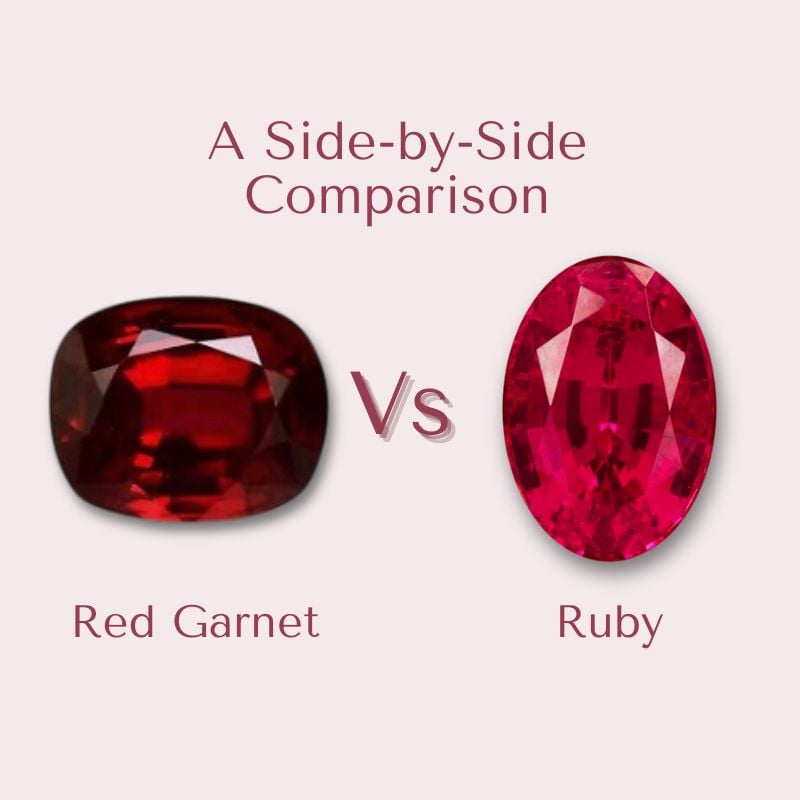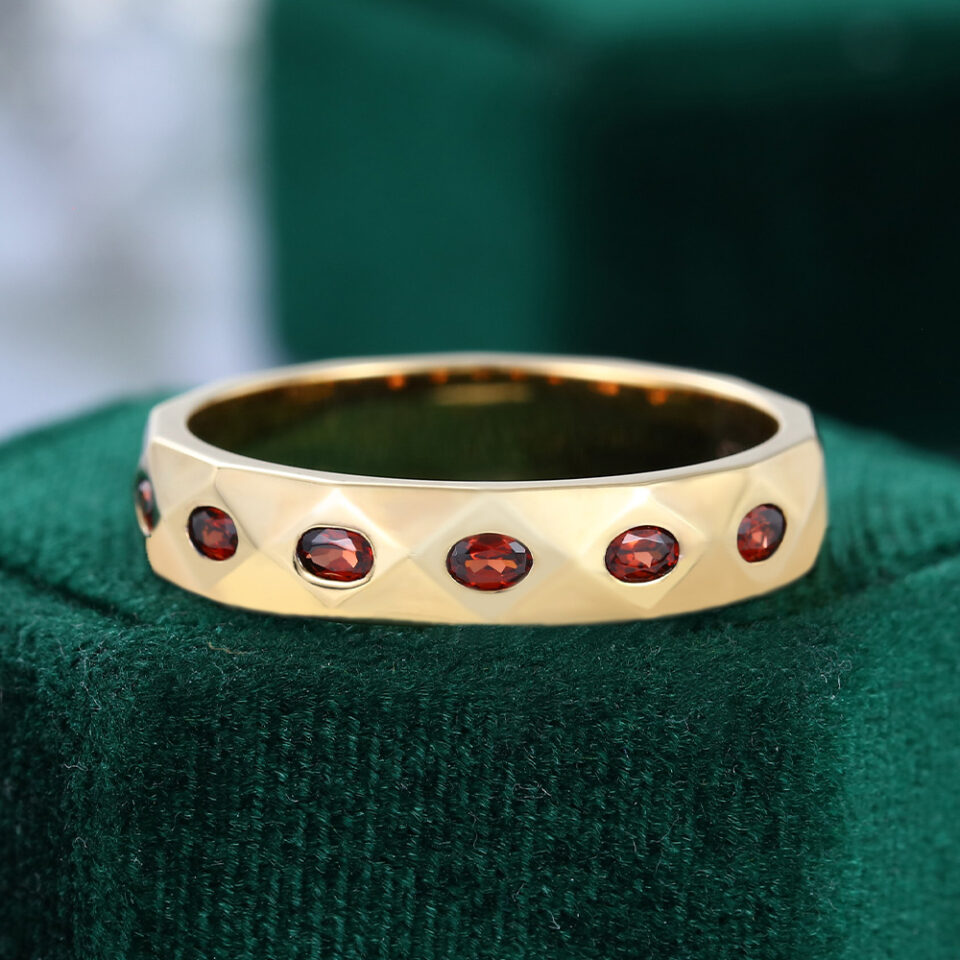Red gemstones are often associated with passion, love, and strength. When searching for a red gemstone, Red Garnet and Ruby frequently appear as top contenders. Although they may look similar at first glance, they differ significantly in composition, color, value, and more. So, what exactly sets Red Garnet and Ruby apart? Which one is a better fit for you? Let’s take a closer look…

Different Historical Backgrounds
Ruby has long been hailed as the “king of gemstones”, symbolizing royalty and nobility. In Indian and Burmese cultures, rubies represent victory and protection, embodying strength. Red Garnet, on the other hand, also has an ancient history but is more closely tied to everyday life. In ancient Egypt, people wore it as a talisman for safe return, and it also symbolized loyalty and friendship.
Not All Reds Are the Same
At first glance, both Ruby and Red Garnet display a captivating red hue. But on closer inspection, the differences become clear:
- Red Garnet typically leans toward warm reddish-brown or wine red tones, and some may even have an orange tint.
- Ruby usually features a highly saturated bright red color, sometimes with orange, blue, or purple undertones. The most prized hue is known as “pigeon blood”—a vivid red with a bluish fluorescence, which is considered the most valuable type of ruby. Rubies with orange or purple undertones are generally less valuable.
If you prefer a cool and intense red, Ruby might be more suitable for you. If you’re drawn to a vintage, warm red tone, Red Garnet is worth considering.
Differences in Chemical Composition and Coloring Elements
Red Garnet belongs to the garnet family and is the most common color in that group. There are several types of red garnet, and their red color mainly comes from iron (Fe) and manganese (Mn). In some varieties (such as pyrope), chromium and vanadium are the coloring agents.
Ruby is a red variety of the mineral corundum (aluminum oxide, Al₂O₃). Its red color is caused by trace amounts of chromium (Cr³⁺) replacing aluminum in the crystal structure. Chromium also causes fluorescence, which makes rubies particularly brilliant under sunlight or ultraviolet light.
Clarity and Brilliance
Red Garnet typically has high clarity, with inclusions rarely visible to the naked eye. This makes it a popular choice for beaded jewelry and pavé settings.
Inclusions are more common in Ruby and are considered a natural part of the gemstone—even high-quality rubies often display them.
Under light, Ruby’s refractive index (1.762–1.778) and fluorescence often give it a more striking sparkle. In contrast, Red Garnet (1.714–1.888) offers a soft, understated luster.
Price: A Significant Difference
Red Garnet is generally more affordable. Even high-quality specimens usually cost only a few hundred dollars per carat, making it an ideal choice for entry-level gemstone lovers or budget-conscious buyers who still want a luxurious look.
Ruby, on the other hand, is significantly more expensive. Its rarity and strong market demand make it one of the most valuable gemstones. High-quality natural rubies can range from several thousand to tens of thousands of dollars per carat. Pigeon blood rubies from Myanmar can command prices upwards of tens of thousands per carat.
Durability
Red Garnet has a hardness of 6.5–7.5, which is sufficient for everyday wear, but it should be handled with care to avoid chipping or damage from impact. Because of this, garnet is often better suited for earrings, pendants, and other pieces less prone to knocks than rings.
Ruby, with a hardness of 9, is considered a highly durable gemstone. It’s well-suited for daily wear and is especially ideal for engagement rings or everyday rings meant to be worn for extended periods.
Origin and Rarity
Red Garnet is relatively abundant, with sources in almost every part of the world. Major production areas include the United States, India, Tanzania, Australia, and the Czech Republic, making garnet relatively easy to find.
Ruby is one of the rarest gemstones, and it is grouped with diamonds, sapphires, and emeralds among the four precious gemstones. The most renowned rubies come from Myanmar, known for producing top-quality stones. Other important sources include Mozambique, Thailand, Tanzania, and Sri Lanka, though high-quality rubies remain extremely rare.
Meaning and Symbolism
Red Garnet symbolizes loyalty, friendship, and safe travels, making it a popular protective talisman and an ideal gift for friends or family. It is also associated with the root chakra but is more commonly believed to restore emotional balance, boost creativity, and enhance a sense of security. Additionally, Garnet is the sole birthstone for January.
Ruby represents love, passion, power, and courage, and is often chosen for engagement rings or special milestones. Spiritually, ruby is believed to activate the root chakra, bringing energy and confidence, perfect for those seeking motivation and inner strength. It is also the exclusive birthstone for July.
If you’re looking for a gemstone tied to your birth month or with meaningful symbolism, this could help guide your decision.
Treatment and Enhancements
Red Garnet is rarely treated and typically remains in its natural state.
Most commercial-grade rubies undergo heat treatment to enhance color and clarity. This process is widely accepted in the industry.
Quick Comparison: Red Garnet vs. Ruby
| Property | Red Garnet | Ruby |
|---|---|---|
| Chemical Formula | General formula: X₃Y₂(SiO₄)₃ | Al₂O₃:Cr |
| Mineral Family | Garnet Group | Corundum |
| Mohs Hardness | 6.5–7.5 | 9 |
| Refractive Index | 1.714–1.888 | 1.762–1.778 |
| Specific Gravity | 3.47–4.15 | ~4.00 |
| Typical Colors | Deep red, brownish red, purplish red, orange-red | Pure red to slightly purplish red |
| UV Fluorescence | Usually none | Strong red fluorescence |
| Birefringence | None | 0.008–0.010 |
| Clarity | Usually eye-clean | Inclusions common |
| Rarity | Common | High-quality stones are rare |
| Typical Price Range | Tens to hundreds of USD per carat | Hundreds to tens of thousands USD per carat |
Red Garnet vs. Ruby: Which Should You Choose?
Choose Ruby if you:
- Are looking for a high-end gemstone to pass down
- Prefer rich, vivid hues with intense brilliance
- Plan to create an engagement ring or daily-wear jewelry
- Are interested in collecting or investing in gemstones
Choose Red Garnet if you:
- Want a red gemstone on a budget
- Love soft, understated warm tones
- Enjoy experimenting with styles for everyday wear
- Are looking for a meaningful, symbolic gift for a friend or loved one
How to Tell Ruby from Red Garnet?
If you’re trying to distinguish between these two gemstones, here are a few simple identification methods:
- Color: Rubies often appear brighter and more vivid in red, while Red Garnets usually have a brownish undertone, making them look darker.
- Hardness: Ruby is harder than garnet. A ruby can scratch a garnet, but a garnet cannot scratch a ruby. (Use this method with caution, as it can damage your stones.)
- Fluorescence: Rubies typically emit strong fluorescence under UV light. Most Red Garnets do not, though some types of pyrope garnet may show faint fluorescence.
- Inclusions: Most rubies display visible inclusions, even to the naked eye. Red Garnets, on the other hand, are generally eye-clean.
If you want to be absolutely sure, it’s best to use professional testing methods. Tools like refractometers, specific gravity testers, spectrometers, microscopes, and Mohs hardness testers can offer more accurate identification.
Conclusion: Different Reds, Equally Captivating
Ruby and Red Garnet may differ in style, but each holds its own unique allure—one burns with fiery passion, the other glows with rich warmth.
Whichever you choose, remember: the best gemstone is the one that feels right for you.
If you’re currently looking for a ruby ring or a red garnet ring, take a moment to explore our curated collection. Every gem is handpicked to capture those heart-stirring moments just for you.



